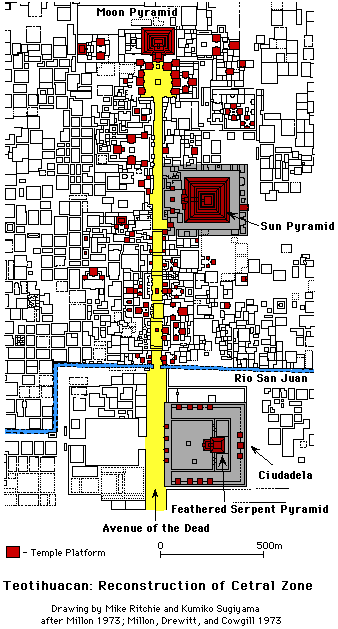
TERMS
Pre-Columbian
Citadel
Roof comb
Fresco
Twining
Tapestry
Effigy
Quetzalcoatl
Stele
Atlantids
Adobes
Embroidery
Tablero - terraced "friezes" with tenon
heads on pyramids
SLIDES
Meso American
Olmec
Colossal head, San Lorenzo, Basalt, 10$. & 20 tons
Offertory Group, Jadeite, 900 - 400 B.C.
Seated Figure, Las Bocas, Ceramic, 13 x 12.5”,
Teotihuacan
Avenue of the Dead, Pyramid of the Sun & the Moon, Valley of Mexico, ca.
100 B.C. - A. D. 750
Pyramid of the Moon,
Citadel
Temple of Quetzalcoatl
900-400 B.C.
ca. 1000 B.C.
Mayan
Ball Court, Copan, Honduras A.!). 735
Temple I (Temple of the Giant Jaguar), Tikal, Peten, Guatemala, ca. 700
Pascal’s Sarcophagus Lid, Temple of Inscriptions, ca. 683
Tenon head, Temple 22, Copan, Honduras ca. 700 - 750
Figurine, from Jaina Island, Mexico, ceramic, 16 x 9” ca. 600
Vase with Figures, Black Ground, terra cotta, 6 7/8 x 5 3/4” ca. 750 -
780
Toltec
Colossal atlantids, Pyramid B, Tula, Hidalgo, Mexico, Stone, 16’ ca. 900
- 1180
South American
Chavin
Stirrup-spouted baffle, black & red ware, North Coast Peru, ca. 800 - 300
B.C.
Nasca
Owl Man, Nazca Plain, Nasca, Peru, ca. A.D. 400-600
Moche
Pair of Ear Ornaments, gold with semiprecious stones, Peru, 4” ca. A.D.
200 - 500
Tiwanaku
Gateway of the Sun, Bolivia, ca. A.D. 375 - 700
North American
Woodland
Serpent Mound, Mississippian, Ohio, 1200 x 20 x 5’, late 11th cent.
Southwest
Cliff Palace, Anasazi, Mesa Verde, Colorado, ca.A.D. 1150-1300
Links:
Teotihucuan:
http://archaeology.la.asu.edu/teo/
http://researchmag.asu.edu/articles/pyramid.html
DJB In-Depth Notes:
Teotihucuan
Except for the Ciudadela and the Great Compound, the major monumental constructions
in the city were concentrated in its northern section along the Avenue of the
Dead, as seen in this map. Many construction units along the avenue, as well
as residential compounds, have been excavated and consolidated by projects of
the National Institute of Anthropology and History in Mexico.
The largest single construction, the Sun Pyramid, stands in the middle of the northern section of the Avenue of the Dead as the principal pyramid of the city, while the second largest pyramid, the Moon Pyramid, is located at the northern end of the Avenue of the Dead.

The Ciudadela ("Citadel") has been extensively excavated by several projects as described in the Feathered Serpent Pyramid pages. However, the Great Compound, interpreted as probably enclosing the city's principal marketplace by Millon, has not been excavated, except for several test pits and a small portion in its northeastern corner.
Rectangles on the map represent apartment compounds recorded by the Teotihuacan Mapping Project. Several residential complexes, such as Tetitla and Zacuala, seen in this map, are completely excavated, consolidated, and currently open to the public. These unique structures characterized one of the largest, most populous, and highly planned ceremonial centers in the New World.
Source: http://archaeology.la.asu.edu/teo/
… is told that when (all) was in darkness, when yet no sun had shone and no dawn had broken ... the gods gathered together and took counsel among themselves at Teotihuacan.
Aztec myth translated in the 16th century A.D. by Franciscan Friar Bernardino de Sahagún
In the 16th century, Spanish officials made reports to King Philip II about a curious village nestled amongst ancient pyramids in the Basin of Mexico. Here, the Aztec natives lived in dwellings that looked more like palaces than homes. Many spoke of ancient times when their small town was a thickly populated metropolis. They called it Teotihuacan: the "City of the Gods." Legends told of how the gods had built the monuments in the older part of the city
Source: http://researchmag.asu.edu/articles/pyramid.html
Notes:
Tapioca is basically a root starch derived from the cassava,
or yuca plant. It's often used to thicken soups and sweeten the flavor of baked
goods, and it makes a dandy pudding.
The cassava plant is native to South America and the West Indies, where its
thick, fibrous roots are used in a variety of forms: bread flour, laundry starch,
an alcoholic brew, and of course, tapioca pudding. As the Encyclopedia Britannica
tells us, it was probably first harvested by the Mayans
- Source: http://ask.yahoo.com/ask/20010702.html